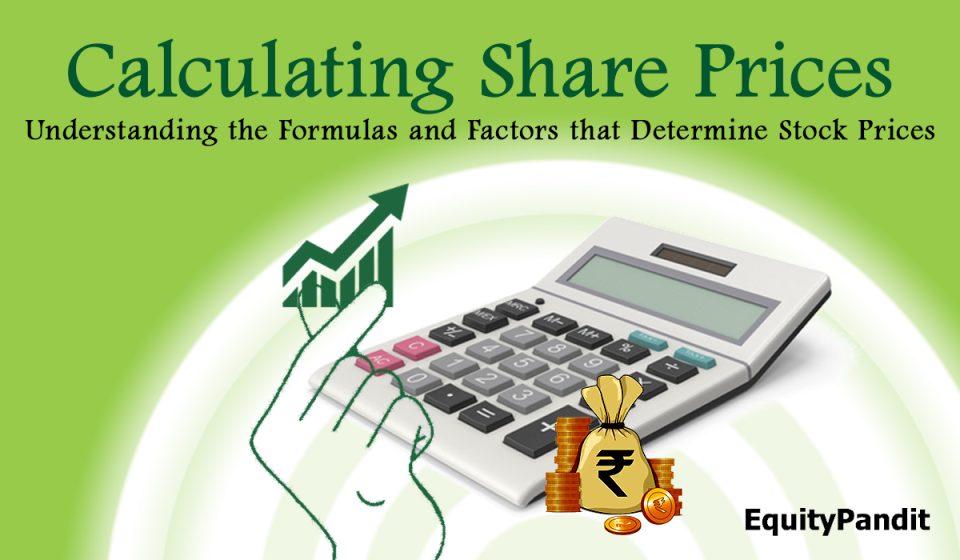Introduction
Have you ever thought or ever got to know how share prices are determined? In this blog, we have covered the share price calculation and aspects related to it. The market’s demand-supply dynamics determine stock values. Stock exchanges determine real-time prices based on the highest volume of traded shares.
A share’s intrinsic value is calculated based on the market’s perception of a company’s value. Share prices are influenced by factors such as company performance, macroeconomic conditions, and investor sentiment. Investors purchase shares to sell them at a higher price for a profit.
Share prices are influenced by factors such as a company’s financial performance, earnings reports, dividends, news about mergers and acquisitions, and broader market trends.
What Is The Share Price Of A Company?
Share price is the price at which one can buy one unit of a company’s stock. In reality, it is a floating and dynamic price as influenced by the market dynamics. Normally, if the company does well, then its share price is bound to escalate, but diminishes if things do not go so well with it.
Share valuation is the method of ascertaining the value of shares in a company. Share valuation is based on quantitative techniques, and share value will change with market demand and supply.
The price of shares of publicly quoted companies is easily accessed; however, measuring the value of shares for private companies whose shares are not traded publically is crucial and difficult.
Why Is The Valuation Of A Share Important?
Valuing publicly traded shares can be intricate. Market quotes may not always accurately represent the true value, particularly when transferring large blocks of shares. In these scenarios, seeking professional advice and having a comprehensive grasp of share valuation is crucial.
The following are some situations where share valuation holds significance:
- One important instance is when preparing to sell your business and needing to determine its value.
- When seeking a loan from your bank with shares as collateral.
- Valuation of shares is crucial in situations such as mergers, acquisitions, reconstructions, and amalgamations.
- When converting company shares, for example, from preference to equity.
- Valuation is necessary when implementing an employee stock ownership plan (ESOP).
- For tax assessments under the wealth tax or gift tax acts.
- In legal cases where share valuation is mandated.
- Shares held by an investment company.
- Compensation for shareholders in the event of company nationalisation.
What Is The Intrinsic Value Of A Share?
Intrinsic value represents the estimated value found through the process of fundamental analysis for an asset like a company, stock, currency, or product, taking into account both tangible and intangible factors. These factors include issues of financial health, competitive advantage, and growth potential.
It is referred to as the “real” value and, consequently might be different from the current market value. This tells the price which a rational investor may be willing to pay for an investment based on the level of its risk and degree of returns expectation.
How To Determine The Share Price Of A Company?
There are primarily three methods for valuing the stocks or share price of a company.
The methods are mentioned below.
1. Asset-based Approach
Valuing shares based on a company’s assets and liabilities, including intangible assets and contingent liabilities, can be very useful for businesses with a large amount of capital assets, such as manufacturers and distributors.
This method verifies the conclusions reached through income or market approaches. The value of the company’s net assets is divided by the number of shares to determine the value of each share.
When using this method, it’s important to consider the company’s entire asset base, including current assets and liabilities like receivables, payables, and provisions. Fixed assets should be considered at their realizable value, and intangible assets like goodwill must be valued. Additionally, unrecorded assets and liabilities need to be taken into account.
Certain assets, such as preliminary expenses, discounts on the issue of shares and debentures, and accumulated losses, should be excluded. To find the net value of assets, subtract all external liabilities from the company’s total asset value. The resulting net value of assets should then be divided by the number of equity shares to determine the share’s value.
Formula For Calculation Of The Share Price Of A Company
The formula used for calculating through the asset-based approach is as follows:
Value per share = (Net Assets – Preference Share Capital) / (No. of Equity Shares)
Implications Of This Method
An asset-based approach can be used when a company is highly capital-intensive and has invested heavily in capital assets or when there is massive capital work in progress. The approach can also be used in estimating the value of shares during companies’ consolidation, absorption, or liquidation.
Additionally, this method is suitable for valuing shares during companies’ amalgamation, absorption, or liquidation.
2. Market-based Approach
For a market-based approach, one typically looks at the share prices of comparable publicly traded companies’ assets or stock sales.
The exhaustive process of selecting comparable companies takes into account major considerations such as the nature and scale of the business, industry, size, and the financial status of similar companies coupled with the date of the transaction and so on. When utilising the yield method, which represents the expected rate of return on investment, there are two distinct approaches to consider:
i) Earning Yield
In this method, shares are valued based on projected earnings and the standard rate of return. The value per share is determined using the following formula:
Expected Rate of Earning = (Profit After Tax/Paid up Value of the Equity Capital) *100
Value per share = (Expected Rate of Earning/ Normal Rate of Earning) * Paid up value of Equity Capital
ii) Dividend Yield
This method values shares based on the anticipated dividend and the standard rate of return. The value per share is calculated using the following formula:
The anticipated dividend rate is computed using a specific formula: (profit available for dividend divided by paid-up equity share capital) multiplied by 100.
Expected rate of dividend = (profit available for dividend/paid-up equity share capital) X 100
3. Income-based Approach
This method is employed when assessing a small number of shares. In this case, the focus is on the anticipated returns from the business investment, meaning what the business is expected to generate in the future.
A common approach involves determining a business’s worth by dividing its projected earnings by a capitalisation rate. Two other techniques are utilised, including Discounted Cash Flow (DCF) and Price Earning Capacity (PEC).
The DCF method, which forecasts future cash flows, is appropriate when such data is reasonably accessible. Conversely, the PEC method, based on historical earnings, does not apply to newly established entities.
Established entities can employ PEC, while newly launched businesses or companies with fluctuating short-term earnings expectations may benefit from more intricate analyses, such as discounted cash flow analysis.
The value per share is computed based on the company’s earnings available for distribution. This can be ascertained by subtracting reserves and taxes from the net profit. The steps for determining the value per share under the income-oriented approach are as follows:
1. Obtain the company’s earnings (available for dividends)
2. Obtain the data for capitalised value
3. Calculate the share value (Capitalised value/Number of shares)
Note: The capitalised value is calculated as follows:
= (Profit available for equity dividends/Normal rate of return) *100
Frequently Asked Questions (FAQs)
What is the Capitalization rate?
This is the expected rate of return from the investment made. Capitalisation rate is the net operating income divided by its current market value.
What is the Market value of a company’s share?
The market value of a company’s share means the actual value paid for the company’s share in the market.
What if the intrinsic value of the share is greater than the market price of the share?
If the intrinsic value of a company’s share is greater than the market value then it is said to be undervaluation of shares.
What are the advantages of the undervalued share price?
When the shares are undervalued then the shares can be brought at a lower price, and then if the value of shares increases, then it can be sold at a higher value. Thus, such situation helps in making profits for the investor.
How to calculate the intrinsic value of a share?
Intrinsic Value = Earnings Per Share (EPS) x (1 + r) x P/E Ratio. The P/E ratio is the Market price of the share divided by the Earnings per share, and ‘r’ is the normal rate of return
What is the normal rate of return and on what factors it depends on?
The required rate of return, also known as normal rate of return is the net gain or loss over a specified period of time from an investment. It depends on factors such as the expected rate of inflation, risk of the investment, and current market interest rates.
What is the formula for the rate of return from an investment?
The rate of return is the current value less the initial value divided by the initial value, whole multiplied by 100.
The future of investing is here!
Unicorn Signals leverages advanced AI technology to provide you with powerful market predictions and actionable stock scans. Download the app today and 10x your trading & investing journey!
 Live
Live

